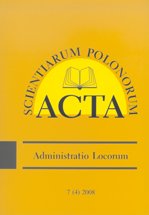Przekształcenia historycznych układów przestrzennych wsi w strefie podmiejskiej Olsztyna, ze szczególnym uwzględnieniem Brąswałdu, Dorotowa i Jonkowa
Changes to historical spatial arrangements of villages within Olsztyn suburban area, with particular reference to Brąswałd, Dorotowo and Jonkowo
Author(s): Sławomir SobotkaSubject(s): Human Geography, Rural and urban sociology
Published by: Wydawnictwo Uniwersytetu Warmińsko-Mazurskiego w Olsztynie
Keywords: changes to historical spatial arrangements of villages;degradation of villages;suburban area;inflow of people;comparative cartography;
Summary/Abstract: This paper presents the results of research for PhD thesis entitled: “Spatial development within Olsztyn suburban area against the background of Changes to Agricultural Landscape”. Spatial range of the research covered all villages situated within Olsztyn suburban area. In order to illustrate changes to rural arrangements, data of the second half of the 19th century, of the years 1920s and 1930s, and the contemporary data (of the years 2010–2013) were compared. Villages were located in Olsztyn suburban area from the 14th to the 19th century. Subdivision of landed estates in the 19th century initiated changes to rural settlement arrangements. In particular, after the Second World War, disturbances occurred to the originally existing spatial arrangement of villages. In the 1970s, this was due to the development of multi-family residential buildings and outbuildings associated with the location of State Agricultural Farms (PGRs). Historical spatial arrangements of villages (oval village, linear village and row village), being subject to moderate building pressure (as compared to the values found in villages located within Olsztyn suburban area) have primarily got degraded, while those with heavy construction traffic have got homogenized i.e. have been changed into multi-road arrangements. What is thus being formed is the “space without qualities”. The phenomenon addressed in the paper is relating to both the volumes of people inflow and the development of single-family residential buildings, in particular after the year 2000 (suburbanization process), and the emergence of new, often ineffective network of access roads. Most villages in Olsztyn suburban area were characterized with the inflow of people in the years 2000–2010, while for the rest of them, the inflow was either equal to zero or negative. In the period under study, a significant increase in the population (over 50 people) took place in 36 villages (18% of the total). This results in either the emergence of multi-road arrangements or degradation of spatial arrangements of the villages. Total increase in the population size in Olsztyn suburban area amounted to 23.5% in the years 2000–2010. Changes to (degradation of) historical spatial arrangements of villages within Olsztyn suburban area was discussed further based on the example of Brąswałd (commune of Dywity), Dorotowo (commune of Stawiguda), and Jonkowo (commune of Jonkowo).
Journal: Acta Scientiarum Polonorum Administratio Locorum
- Issue Year: 12/2014
- Issue No: 2
- Page Range: 39-57
- Page Count: 19
- Language: Polish

